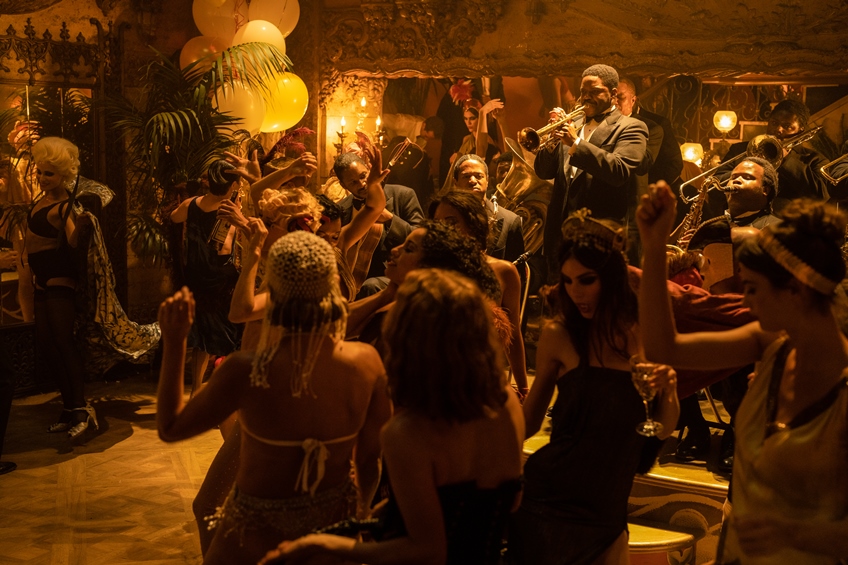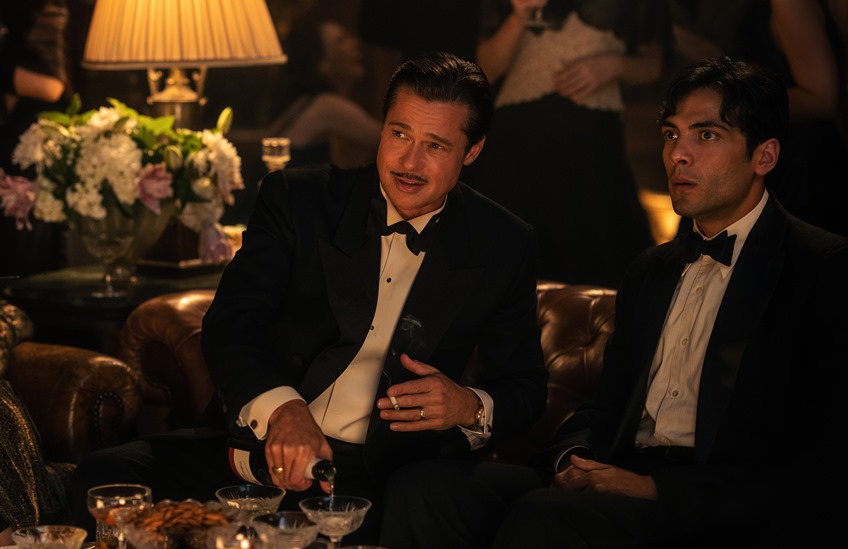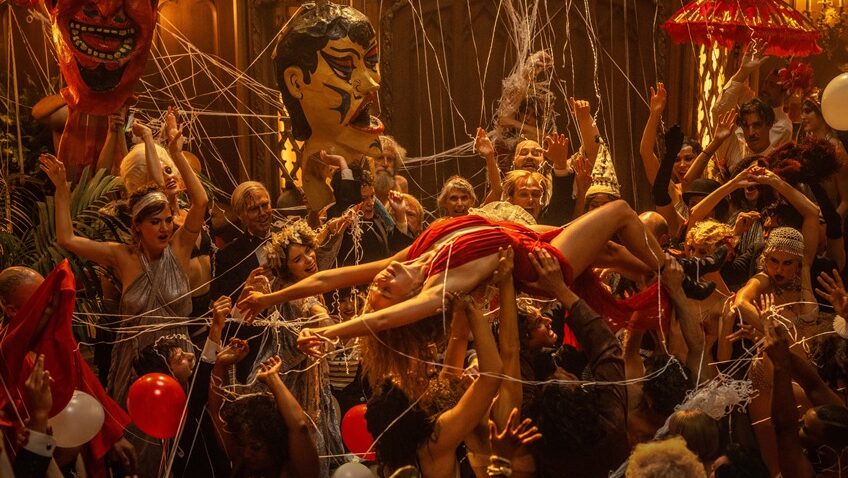Joyce Glasser reviews Babylon (January 20, 2023), Cert 18, 188 mins.
In the first scene of Damien Chazelle’s Babylon, Manuel Torres (Diego Calva) a Mexican dogsbody working for a rich Californian mogul in 1926, is sprayed with elephant dung as he tries to push the frightened animal up to the mansion for a party. Half-way through the film, when Manuel, now Manny, is directing for Kinoscope Studios, he is the recipient of projectile vomiting from film star Nellie LaRoy (Margot Robbie) who, as an aspiring actress, gate crashed that party. In between these markers, these lost souls chase their showbiz dreams as jazz music permeates the frontier boomtown that was Los Angeles.
Anaemic La La Land, Chazelle’s Academy Award winning blockbuster, has been given a transfusion with the blood of Vincent Minnelli’s Two Weeks in Another Town, Guillermo del Toro’s Nightmare Alley, Cecil B. Demille’s Cleopatra and Quentin Tarantino’s Once Upon A Time in Hollywood. Chazelle forces that connection by cheekily recreating the scene in which Sharon Tate (Margot Robbie) goes into a cinema to watch the audience’s positive reaction to her first role. Here, it’s Robbie’s Nellie LaRoy (based loosely on the life of the wild silent screen starlet Clara Bow).
It’s no coincidence that Brad Pitt (excellent here, but in a much leaner role) and Margot Robbie appear in both films. But whereas Tarantino captured 1960’s Hollywood, Chazelle focuses on Singin’ in the Rain – the transition from silent films to talkies – without directors Stanley Donen’s and Gene Kelly’s sanitised veneer.

The darkness is projected literally through claustrophobic interiors and night shoots including the big opening party. It’s Hieronymus Bosch’s Garden of Earthly Delights, where strangers and lovers have sex in plain sight; where everyone is stoned and it’s too loud to hear the ubiquitous jazz band.
The party serves to introduce the large array of characters including the three leads whose trajectories we follow from 1926 to the 1934. And for one, there is a moving coda in 1952, where [spoiler alert] a survivor of the transition enters a cinema to see the newly released Singin’ in the Rain. Now a New York shopkeeper, he breaks down in tears at the mixed memories and broken dreams that the movie evokes.
We meet Manuel “Manny” Torres (newcomer Calva, just missing the charisma and sex appeal of Benicio del Toro), through whose eyes the saga unfolds in 1926. Manny is a security guard and dogsbody at the big party, presumably Randolph Hearst’s The Enchanted Hill at San Simeon, a “castle” in the middle of nowhere known for its celebrity gatherings. Chazelle depicts the Sodom and Gomorrah debauchery, which include a young starlet (Phoebe Tonkin) urinating on the obese stomach of a naked, wasted mogul, before dying, presumably of an overdose.
We also meet gate-crasher Nellie LaRoy who drives up the hill in a jeep, unescorted, with a long, wild mane of blond curls, a large mouth of white teeth unknown in the 1920s, and a red dress slit up the front and the sides, the better to show off the newcomer’s dancing legs. Manny is too smitten to know she’s trouble.
Nellie reassures Manny that she doesn’t need his help, telling him, ‘I’m a star.’ But she needs his help finding cocaine, and later, paying her drug and gambling debts.
You might wish for better writing in the scene connecting these ambitious dreamers, but instead there are declarations of how they want to feel part of “something that matters”. Manny says he want to be part of something bigger than himself.
The crowd clears for the arrival of Jack Conrad (Pitt), a much-married, silent film star at the peak of his fame if past his ability to hold his alcohol. At dawn, it falls to Manny to drive Conrad home where he ogles the vestiges of wealth. Shrewdly, Manny makes himself indispensable to the generous star who is concerned about his old friend and producer George Munn’s (Lukas Haas) depression. Munn is feeling like a has-been. Conrad, based on squeaky voiced John Gilbert, is soon to join him.

Key secondary characters are also introduced, including Chinese-American lesbian cabaret singer Lady Fay Zhu (a kind of May Wong character played by Li Jun Li) who sucks snake venom out of Nellie’s neck in one of the most bizarre scenes of the film, establishing a relationship that goes nowhere. Columnist Elinor St. John (Jean Smart), probably based on Hearst favourite Louella Parsons and studio head Irving Thalberg (Max Minghella) can’t get enough of Jack until 1932 when Elinor publishes an article declaring Conrad is through and Thalberg stops calling.
In a dazzling, daring DeMillean sequence, Chazelle romanticises the spontaneity and excitement of early location shooting. Production shuts down while Manny is charged with finding a new camera to complete a historic battle scene. He proves to have the requisite resourcefulness in a suspenseful race against the fading light.
Intercut with the battle scene and reminding us that until the consolidation of the studio system there were women directors, we see how Ruth Adler (Chazelle’s wife Olivia Hamilton) is impressed by the talent of an upstart stand-in, Ms LaRoy. As Nellie becomes a star, the director takes her through the problematic talkies – hammered out in a long, but accurate scene showing the challenges of capturing sound with noisy cameras, noisier studios, and inexperienced cast and crew.
As the talkies take their toll on Jack, and drugs and gambling on Nellie, Manny, sharp and adaptable, thrives, working his way up to directing silent films. But he sheds his Mexican identity to fit in, and under pressure, persuades an old friend, black trumpet player extraordinaire Sidney Palmer (Jovan Adepo) to blacken his skin with polish to match the rest of the band under the studio lights. Palmer, who is furious and later quits, might be inspired by Ben Webster who began to play (saxophone) in silent films at a very young age in 1927. While highlighting Hollywood’s double-standards and racism, Palmer’s role is never developed.
Less whimsical and contrived than La La Land, and without the bad dancing and singing, Babylon, an unrequited love story that sustains and debunks glossy myths, is easier to swallow, if harder to watch. Based loosely on Hollywood Babylon, Kenneth Anger’s trashy history of Hollywood’s early years, form and content merge as Chazelle recreates the period’s excesses, resulting in an 18 certificate and three-hour plus running time. While many scenes could be cut, there are weird and nightmarish moments, like sweet Tobey Maguire playing a sadistic gangster so unnerving that he gives Joaquin Phoenix’s Joker a run for his money.




